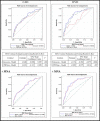Prediction of Prolonged ICU Stay in Cardiac Surgery Patients as a Useful Method to Identify Nutrition Risk in Cardiac Surgery Patients: A Post Hoc Analysis of a Prospective Observational Study
- PMID: 30506711
- PMCID: PMC7379574
- DOI: 10.1002/jpen.1486
Prediction of Prolonged ICU Stay in Cardiac Surgery Patients as a Useful Method to Identify Nutrition Risk in Cardiac Surgery Patients: A Post Hoc Analysis of a Prospective Observational Study
Abstract
Background: Cardiovascular surgery patients with a prolonged intensive care unit (ICU) stay may benefit most from early nutrition support. Using established scoring systems for nutrition assessment and operative risk stratification, we aimed to develop a model to predict a prolonged ICU stay ≥5 days in order to identify patients who will benefit from early nutrition interventions.
Methods: This is a retrospective analysis of a prospective observational study of patients undergoing elective valvular, coronary artery bypass grafting, or combined cardiac surgery. The nutrition risk was assessed by well-established screening tools. Patients' preoperative EuroSCORE (European System for Cardiac Operative Risk Evaluation), primary disease, and intraoperative cardiopulmonary bypass (CPB) time were included as independent variables in a multivariate logistic regression analysis to predict a prolonged ICU stay (>4 days).
Results: The number of cardiac surgery patients included was 1193. Multivariate analysis revealed that for prediction of ICU stay >4 days, both Nutritional Risk Screening 2002 (area under the curve (AUC): 0.716, P = .020) and Mini Nutritional Assessment (MNA) score (AUC: 0.715, P = .037) were significant, whereas for prediction of ICU stay >5 days, only the MNA score showed significant results (AUC: 0.762, P = .011).
Conclusion: Present data provide first evidence about the combined use of EuroSCORE, primary disease, CPB time, and nutrition risk screening tools for prediction of prolonged ICU stay in cardiac surgery patients. If prospectively evaluated in adequately designed studies, this model may help to identify patients with prolonged ICU stay to initiate early postoperative nutrition therapy and thus, facilitate an enhanced recovery.
Keywords: ICU stay; cardiac disease; cardiac surgery; nutrition; nutrition assessment; nutrition screening tools; nutrition support practice; outcomes quality; outcomes research; parenteral nutrition; prediction model; research and diseases.
© 2018 The Authors. Journal of Parenteral and Enteral Nutrition published by Wiley Periodicals, Inc. on behalf of American Society for Parenteral and Enteral Nutrition.
Figures





Similar articles
-
A preoperative and intraoperative predictive model of prolonged intensive care unit stay for valvular surgery.J Heart Valve Dis. 2006 Mar;15(2):219-24. J Heart Valve Dis. 2006. PMID: 16607904
-
Prediction of Patient Length of Stay on the Intensive Care Unit Following Cardiac Surgery: A Logistic Regression Analysis Based on the Cardiac Operative Mortality Risk Calculator, EuroSCORE.J Cardiothorac Vasc Anesth. 2018 Dec;32(6):2676-2682. doi: 10.1053/j.jvca.2018.03.007. Epub 2018 Mar 7. J Cardiothorac Vasc Anesth. 2018. PMID: 29678435
-
Prognostic value of nutritional screening tools for patients scheduled for cardiac surgery.Interact Cardiovasc Thorac Surg. 2013 May;16(5):612-8. doi: 10.1093/icvts/ivs549. Epub 2013 Jan 29. Interact Cardiovasc Thorac Surg. 2013. PMID: 23360716 Free PMC article.
-
Effectiveness of dexmedetomidine versus propofol on extubation times, length of stay and mortality rates in adult cardiac surgery patients: a systematic review and meta-analysis.JBI Database System Rev Implement Rep. 2018 May;16(5):1220-1239. doi: 10.11124/JBISRIR-2017-003488. JBI Database System Rev Implement Rep. 2018. PMID: 29762314
-
Survival, Quality of Life, and Functional Status Following Prolonged ICU Stay in Cardiac Surgical Patients: A Systematic Review.Crit Care Med. 2019 Jan;47(1):e52-e63. doi: 10.1097/CCM.0000000000003504. Crit Care Med. 2019. PMID: 30398978
Cited by
-
Perioperative Vitamin C and E levels in Cardiac Surgery Patients and Their Clinical Significance.Nutrients. 2019 Sep 9;11(9):2157. doi: 10.3390/nu11092157. Nutrients. 2019. PMID: 31505814 Free PMC article.
-
Nutritional Considerations of Cardiovascular Diseases and Treatments.Nutr Metab Insights. 2019 Mar 22;12:1178638819833705. doi: 10.1177/1178638819833705. eCollection 2019. Nutr Metab Insights. 2019. PMID: 30923440 Free PMC article. Review.
-
Reply: Prediction remains difficult-in particular when it involves the future!JTCVS Open. 2021 Oct 13;8:506. doi: 10.1016/j.xjon.2021.10.002. eCollection 2021 Dec. JTCVS Open. 2021. PMID: 36004066 Free PMC article. No abstract available.
-
Longitudinal Outcomes in Octogenarian Critically Ill Patients with a Focus on Frailty and Cardiac Surgery.J Clin Med. 2020 Dec 23;10(1):12. doi: 10.3390/jcm10010012. J Clin Med. 2020. PMID: 33374545 Free PMC article.
-
Performance of the comprehensive nutrition screening index in predicting mortality after cardiac surgery.Sci Rep. 2024 Nov 18;14(1):28507. doi: 10.1038/s41598-024-78114-x. Sci Rep. 2024. PMID: 39557984 Free PMC article.
References
-
- Wray CJ, Mammen JMV, Hasselgren P‐O. Catabolic response to stress and potential benefits of nutrition support. Nutrition. 2002;18(11‐12):971‐977. - PubMed
-
- Plank LD, Hill GL. Energy balance in critical illness. Proc Nutr Soc. 2003;62(2):545‐52. - PubMed
-
- Reid CL. Nutritional requirements of surgical and critically‐ill patients: do we really know what they need? Proc Nutr Soc. 2004;63(3):467‐472. - PubMed
-
- Villet S, Chioléro RL, Bollmann MD, Revelly J‐P, Cayeux RN M‐C, Delarue J, et al. Negative impact of hypocaloric feeding and energy balance on clinical outcome in ICU patients. Clin Nutr. 2005;24(4):502‐509. - PubMed
-
- Reid C. Frequency of under‐ and overfeeding in mechanically ventilated ICU patients: causes and possible consequences. J Hum Nutr Diet. 2006;19(1):13‐22. - PubMed
Publication types
MeSH terms
LinkOut - more resources
Full Text Sources
Medical

